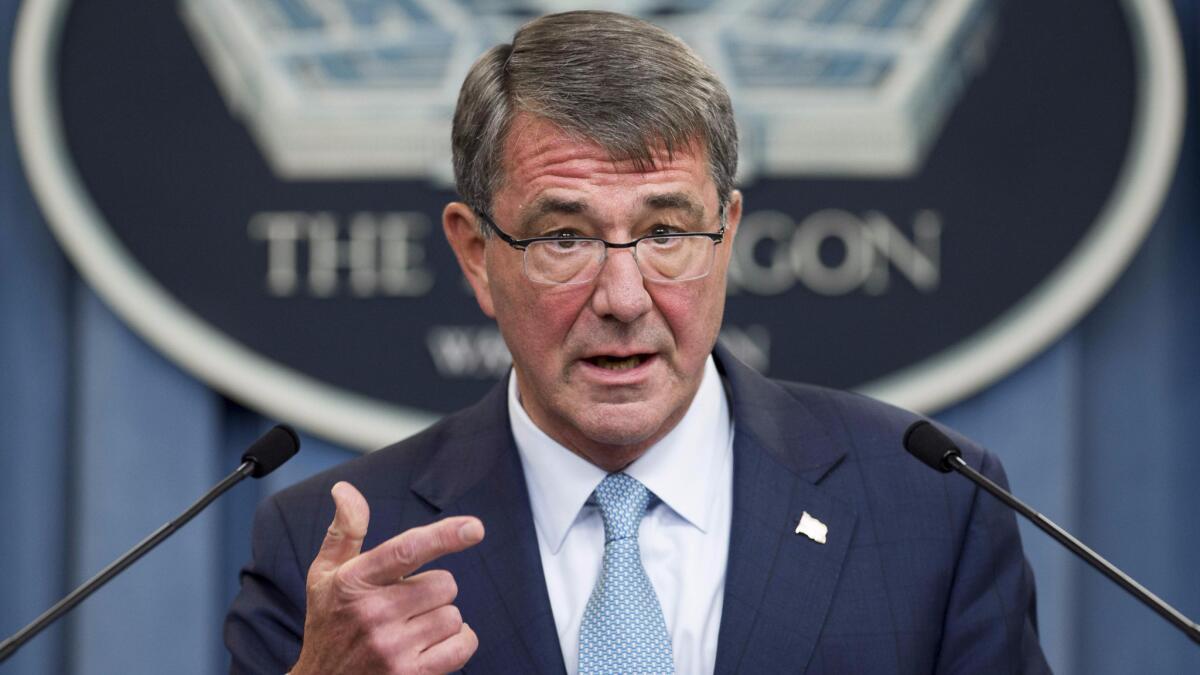U.S. is one of many countries allowing transgender military personnel

- Share via
The Pentagon’s decision to allow transgender personnel in the military is a milestone for the U.S., but it isn’t a new concept around the world.
The U.S. joins 18 other countries – including Australia, Israel, Britain, Sweden and Canada – that allow transgender military personnel. The Netherlands was the first to drop its ban in 1974.
Defense Secretary Ashton Carter set a deadline of July 1, 2017, to implement the new policy in this country. The new policy was announced last month.
The shift has been studied for years with the U.S. military looking at how other countries have tackled the change.
In 2014, the Palm Center, a San Francisco-based LGBT research institute, sponsored a conference in Washington, D.C., with the American Civil Liberties Union, bringing together defense officials and transgender service members from foreign militaries.
Palm Center director Aaron Belkin said the top priority of the services was to maintain military readiness. “They all said the same thing, which is that inclusive policy has not in any way compromised military readiness. And that’s really important,” Belkin said.
Still, each country has taken slightly different approaches to the policy.
Transgender generally describes people who don’t identify with their assigned gender at birth. The Palm Center estimates there are about 12,600 transgender people serving in the U.S. military, out of a total of 2 million active and reserve service members.
Argentina has the most liberal policy. Individuals there are not required to undergo surgery or receive an expert’s opinion before officially changing their gender, according to a 2014 report by the Hague Center for Strategic Studies on international military LGBT policies.
Most of the militaries generally accept soldiers who have undergone hormone therapy or surgery to transition to a different gender.
See the most-read stories in Nation this hour »
Belgium will consider only those who have undergone a sex-change operation as transgender, according to the Hague Center study.
Differences arise with people who are in the process of transitioning to another gender.
In the Netherlands, Canada and Australia, the military will pay for hormonal and surgical treatments. The service member must receive approval from a doctor before being allowed to begin the process. The United Kingdom gender recognition act requires individuals to have lived as their target gender for two years in an “experience period” before legal recognition can be granted.
The U.S. will cover medical treatments approved by military physicians, and may do so in as soon as 90 days. A study commissioned by the Pentagon and carried out by the Rand Corp. estimates that U.S. military costs are expected to increase between $2.4 million and $8.4 million with the addition of hormone treatments and transition-related surgeries.
Most foreign militaries follow the British model of issuing a new uniform at the start of the transition process, along with name and photo changes on identification badges. Changing housing and bathroom facilities is more difficult to decide.
The solution is often different for each person and unit. A “gold standard” in dealing with the issue is a 36-page guide by the Royal Australian Air Force, Belkin said, noting its focus on flexibility and understanding of the soldier’s needs.
Due to different housing and bathroom facilities based on location, Canadian Forces College professor Dr. Alan Okros said commanders should “when in doubt use common sense.”
That may mean using shower curtains, making sure individual stalls are available or setting aside separate times for transgender service members to use facilities. However, he cautioned, requiring transgender personnel to use different facilities could be seen as an act of discrimination.
Some detailed policies outline how to handle the re-issuance of medals, honors and awards after a transgender service member has transitioned. While Britain allows transgender personnel to return old medals to get ones with new names, in Canada, medals will not reissued.
None of the services bars transgender personnel from specific jobs – they face the same restrictions as those placed on all soldiers and sailors of a particular gender. The U.S. military eliminated gender restrictions this year, including the ban on women serving in the Navy SEALs and Army Rangers.
Transgender service members are required to meet the specific fitness levels for the gender they transitioned to and are often given time to train to meet the requirements.
The Canadian Forces updated its policies in 2014 from gendered to gender-neutral fitness requirements, said Lt. Col. Monique Goyette, section head of the Directorate of Human Rights and Diversity. This change was made to align with their “universality of service” principle, she said.
Belkin said he believed the transgender policy could be quickly implemented in the U.S., as it has in other countries.
“It’s not difficult to allow people to be honest about who they are,” Belkin said. “You know, militaries act as if military inclusion is some complicated thing and they drag their feet for decades, in some cases centuries, but it’s just really not difficult to pull off as long as you have leadership.”
ALSO
Opinion: Ending the military’s transgender ban will have far more impact than you might think. Here’s why.
10 more states sue over restrooms that transgender students can use
San Diego Pride Parade celebrates military’s plan for transgender troops
More to Read
Sign up for Essential California
The most important California stories and recommendations in your inbox every morning.
You may occasionally receive promotional content from the Los Angeles Times.










